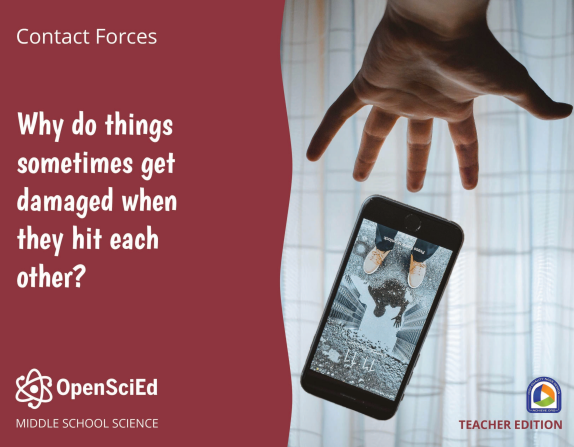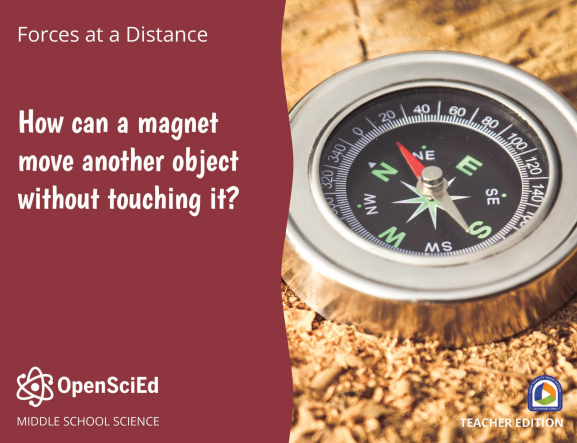EINSTEIN PROJECT CURRICULUM OPTIONS
OPEN SOURCE SCIENCE EDUCATION
eighth Grade
Why do things sometimes get damaged when they hit each other?
8.1 contact forces
16 lessons | 33 days of instruction
Oh, no! I’ve dropped my phone! Most of us have experienced the panic of watching our phones slip out of our hands and fall to the floor. We’ve experienced the relief of picking up an undamaged phone and the frustration of the shattered screen. This common experience anchors learning in the Contact Forces unit as students explore a variety of phenomena to figure out, “Why do things sometimes get damaged when they hit each other?”
Learn more in the Unit Storyline.
SINGLE KIT | $457
All materials for 1 class
MULTI KIT | $620
Materials for 6 sections
ADD-ON | $225
Consumables for 1 class
How can a sound make something move?
8.2 sound waves
14 lessons | 24 days of instruction
In this unit, students develop ideas related to how sounds are produced, how they travel through media, and how they affect objects at a distance. Their investigations are motivated by trying to account for a perplexing anchoring phenomenon — a truck is playing loud music in a parking lot and the windows of a building across the parking lot visibly shake in response to the music.
Learn more in the Unit Storyline.
Interactive Materials for 24 students (working in pairs)
SINGLE KIT | $245
All materials for 1 class
MULTI KIT | $261
Materials for 6 sections
ADD-ON | $42
Consumables for 1 class
How can a magnet move another object without touching it?
8.3 forces at a distance
12 lessons | 30 days of instruction
This unit launches with a slow-motion video of a speaker as it plays music. In the previous unit, students developed a model of sound. This unit allows students to investigate the cause of a speaker’s vibration in addition to the effect. Students dissect speakers to explore the inner workings, and engineer homemade cup speakers to manipulate the parts of the speaker. They identify that most speakers have the same parts–a magnet, a coil of wire, and a membrane. Students investigate each of these parts to figure out how they work together in the speaker system. Along the way, students manipulate the components (e.g. changing the strength of the magnet, number of coils, direction of current) to see how this technology can be modified and applied to a variety of contexts, like MagLev trains, junkyard magnets, and electric motors.
Learn more in the Unit Storyline.
SINGLE KIT | $378
All materials for 1 class
MULTI KIT | $417
Materials for 6 sections
ADD-ON | $106
Consumables for 1 class
How are we connected to the patterns we see in the sky and space?
8.4 earth in space
17 lessons | 31 days of instruction
Humans have always been driven by noticing, recording, and understanding patterns and by trying to figure out how we fit within much larger systems. In this unit, students begin observing the repeating biannual pattern of the Sun setting perfectly aligned between buildings in New York City along particular streets and then try to explain additional patterns in the sky that they and others have observed. Students draw on their own experiences and the stories of family or community members to brainstorm a list of patterns in the sky which are added to their growing list of related phenomena.
Learn more in the Unit Storyline.
SINGLE KIT | $333
All materials for 1 class
MULTI KIT | $426
Materials for 6 sections
ADD-ON | $85
Consumables for 1 class
Why are living things different from one another?
8.5 genetics
17 lessons | 28 days of instruction
This unit on genetics starts out with students noticing and wondering about photos of two cattle, one of whom has significantly more muscle than the other. The students then observe photos of other animals with similar differences in musculature: dogs, fish, rabbits, and mice. After developing initial models for the possible causes of these differences in musculature, students explore a collection of photos showing a range of visible differences. Students figure out that environmental and genetic factors together play a role in the differences we see among living things.
Learn more in the Unit Storyline.
SINGLE KIT | $199
All materials for 1 class
MULTI KIT | $278
Materials for 6 sections
ADD-ON | $62
Consumables for 1 class
How could things living today be connected to the things that lived long ago?
8.6 Natural selection & Common Ancestry
15 lessons | 31 days of instruction
In this unit, students investigate the connections between ancient and modern organisms. Students hear about the surprising fossil of an ancient penguin (nicknamed “Pedro”) in a podcast from the researchers who found and identified the fossil. In the four lesson sets, students then develop a model for natural selection and use it to account for patterns between the body structures and behaviors of ancient organism fossils and similar organisms living today.
Learn more in the Unit Storyline.
SINGLE KIT | $333
All materials for 1 class
MULTI KIT | $636
Materials for 6 sections
ADD-ON | $207
Consumables for 1 class






























